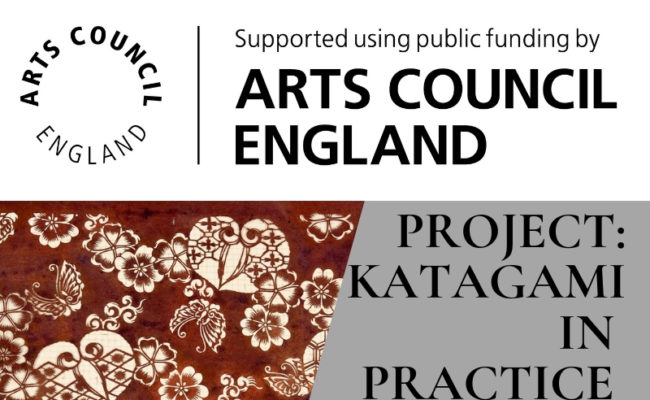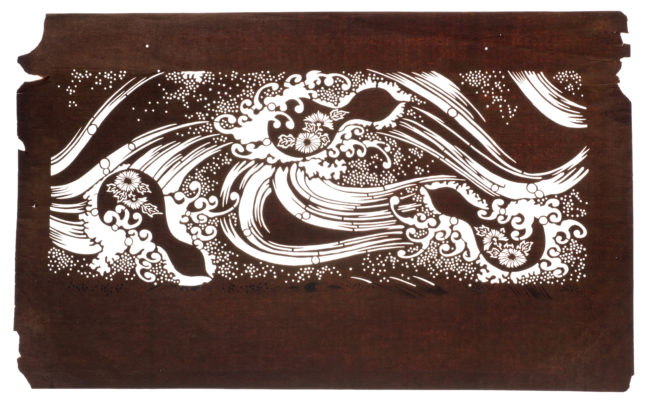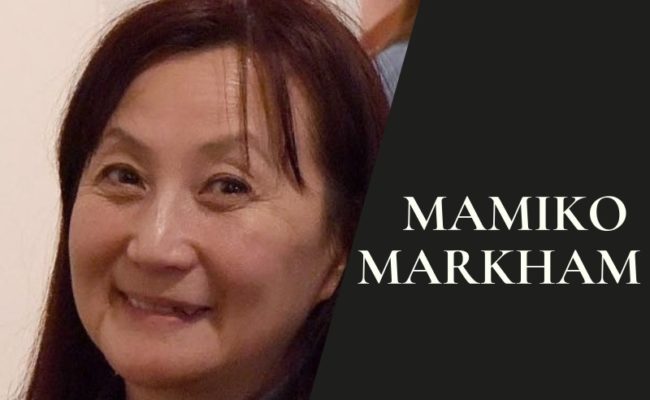‘Oho Nami’ (Great Wave), ‘Hyotan’ (Gourd) and ‘Suehiro’ (spreading out like an open fan) katagami stencil
Brief description
'Oho Nami' (Great Wave), 'Hyotan' (Gourd) and 'Suehiro' (spreading out like an open fan) katagami stencil, 1850 - 1880
Date
1850 - 1880
Dimensions
height: 254mm
width: 413mm
stencil height: 145mm
stencil width: 361mm
More details
The pattern of this Katagami relates to 'Oho Nami' (Great Wave) in the late Edo period (1780-1867). Each element depicts waves spreading widely, whichsymbolises a situation getting better from now on, signifying good luck to come. Sea wave patterns in the late Edo period (1780-1867) frequently use 'Seigaiha' (geometrically repeating waves of the sea). However, this wave pattern is not a geometric 'Seigaiha', but portrayed as sea waves themselves. Great wave patterns on Katagami were used for Oiran geisha and Kabuki actor costumes. The 'Hyotan' (Gourd) represents how the god spirit of nature created this shape as a vessel where the evil of the universe was sealed. Gourds were suspended in front of houses or shops for domestic good luck or for business prosperity. Gourds are simple, uniquely-shaped plants, and were used by common people for holding sake and water. A less obvious element of this katagami design is 'Suehiro' (spreading out like an open fan); the pattern elements are placed to give the appearance of widening in a downwards direction, signifying increasing success. The pattern fashions of the late Edo period (1780 - 1867) always influenced each other, froom Ukiyo-e artists to and from Oiran geisha and Kabuki actors. Katagami merchants also contributed to trends. The great wave art and fashion movement was a typical example of this in the late Edo period. Kabuki actors were wearing costumes of 'Great Wave with Gourd' pattern for performances in Kabuki Opera from around 1828 to around 1867. This practice continues even today. Katagami merchants not only influenced celebrities, but also the ordinary townspeople due to the trends of these patterns. There were many variations such as inserting chrysanthemum in the outline of the gourd, and it was popular as an attractive pattern. Townspeople bought second-hand 'Great Wave with Gourd' pattern kimono being sold on the stalls under the eaves of temples and wore them after repairing them. It became very fashionable and spread to Edo townspeople. 'Great Wave with Gourd' pattern was worn throughout the year regardless of season by townspeople, but being a motif indicating coolness, a lot were produced for spring and summer. These were also often applied to porcelain and pottery. Shimamura is believed to have produced many wave pattern Katagami most certainly influenced from the mania of great wave art. The carp pattern combined with waves was also related to this movement. In the Silver Studio collection k1-12 and k2-22 carp and wave, k2-33 and k2-85 are also patterns related to the wave. This is one of around 400 Japanese katagami stencils which are part of the Silver Studio Collection. The stencils were produced in Japan as a way of applying patterns to fabric, mainly kimonos. The katagami collected by the Silver Studio were used by their designers as reference material to produce their own Japanese-inspired patterns. This Katagami employed the Itoire technique. This is one method of silk thread reinforcement in Katagami. Itoire was a detailed technique which was applied to Katagami by veteran female artisans at Shiroko, Ise, from about 1750. Itoire was used until 1920. See Markham, Mamiko (2018): Katagami technique Itoire. Middlesex University. Journal contribution. https://doi.org/10.22023/mdx.6477776.v1






Comments